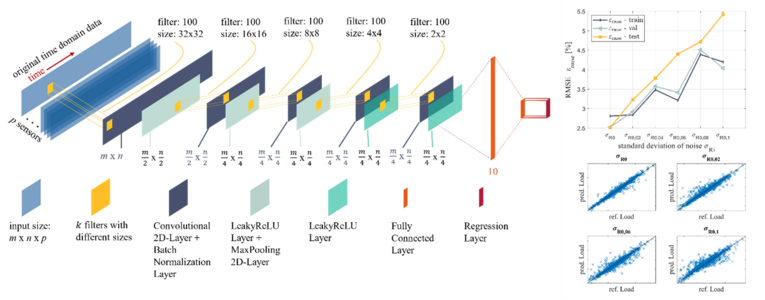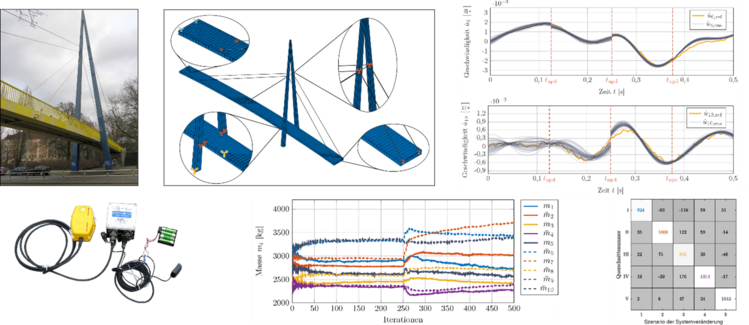LEMOTRA – Lifetime monitoring of structures by means of data assimilation in the digital twin with artificial intelligence
The transport infrastructure in Germany shows a fundamental aging of the structures. For example, the average age of approximately 26,000 railroad bridges is 73.7 years, and that of the steel bridges amongst them is as much as 85.9 years. The network of federal highways in Germany comprises around 40,000 bridges, most of which were built between 1960 and 1985 and are therefore also reaching a critical age. This exhibits the enormous challenge for infrastructure maintenance and life cycle management, which require innovative scientific and technological solutions. The new developments in Information Technologies (IT) such as Cloud Computing, Internet of Things (IoT), Big Data and Artificial Intelligence (AI) are enabling a variety of smart applications for the industry, including Digital Twins (DT) and Building Information Modeling (BIM).
The main objective of the LEMOTRA project is to develop a consistent methodological basis for an intelligent digital representation of structures that establishes lifetime monitoring as the basis for predictive condition assessment and maintenance. A digital twin for structural health monitoring (SHM-DT) will be developed to support a BIM-based structural model that captures all data in compressed digital form. This SHM-DT unifies the extensive and heterogeneous measurement data with physical and mathematical models of different complexity by means of data assimilation and artificial intelligence. SHM-DT will thus be able to provide a robust prognosis for both the real structural behavior and the critical structural parameters such as stiffnesses or damage in real time.
On this basis, meaningful condition indicators will be defined, determined and transferred to the digital structural model. Thus, the LEMOTRA project provides an essential methodological element for linking BIM and SHM in SPP 2388 for the purpose of life cycle management of structures. The most important innovative features of the project are methods for data assimilation in the digital twin and the use of artificial intelligence for automated measurement data evaluation and prediction of structural condition.
The LEMOTRA project also proposes a holistic concept for the monitoring and condition assessment of real structures, defines interfaces between different subtasks and the relevant data, sets its own methodological research priorities and explains the selected research approaches. This general concept for the life cycle management of structures is shown in Figure 1.
The following project sub-goals are reflected in the own work packages and related to the priorities of SPP 2388.
- In the focus of Digital Models (DM), methods for extracting physical models of different complexity and dimensionality from the digital building model (DM1) are to be researched and the development of digital impact models using monitoring and artificial intelligence (DM2) is to be advanced.
- The focus on Digital Linkage (DV) represents the largest part of the research project and serves to develop methods for automated measurement data assimilation in the Digital Twin using Kalman filters and Artificial Intelligence (DV1). Furthermore, methodological components of a digital twin SHM-DT are to be developed and validated using the example of a representative scaled laboratory structure (see Figure 2) (DV2).
- At the same time, a consistent concept for the automated monitoring of structures is being developed (CI1) in the third focus area of condition indicators and lifetime (CI).

Milestones and Highlights:
- Development of a method and interface between IFC-based BIM models and the commercial FE software ANSYS, enabling the automated extraction of various finite element models with differing dimensionality and complexity depending on the requirements of the structural condition assessment.

- Development of a real-time traffic load identification method using a cluster of convolutional neural networks (CNNs), capable of identifying load parameters such as load magnitude, vehicle speed, loaded traffic lane, and current number of vehicles on the bridge based on measured acceleration or strain data.

- Development of a method for real-time model updating using data assimilation to identify system changes and damage by adapting simplified computational models.

- Creation of two FE models of the Nibelungen Bridge with different levels of complexity: one detailed model calibrated to the bridge’s modal properties, from which simplified SHM models are to be derived, and a second already simplified model based on approximate assumptions for comparison purposes.
Contact
Publications
Peer-Reviewed Journal Paper
Rudenko, I.; Petryna, Y.: An Approach to Automatic Building Information Modeling-Based Generation of Finite Element Models of Different Complexity and Finite Element Dimensionality. Buildings 2025, 15, 171. https://doi.org/10.3390/buildings15020171
Becks, H., Lippold, L., Winkler, P., Moeller, M., Rohrer, M., Leusmann, T., Anton, D., Sprenger, B., Kähler, P., Rudenko, I., Arcones, D. A., Koutsourelakis, P.-S., Unger, J. F., Weiser, M., Petryna, Y., Schnellenbach-Held, M., Lowke, D., Wessels, H., Lenzen, A.,…Hegger, J. (2024). Neuartige Konzepte für die Zustandsüberwachung und -analyse von Brückenbauwerken – Einblicke in das Forschungsvorhaben SPP100+/Novel Concepts for the Condition Monitoring and Analysis of Bridge Structures – Insights into the SPP100+ Research Project. Bauingenieur, 99(10), 327-338. https://doi.org/10.37544/0005-6650-2024-10-63
Kähler, P.: Einsatz von Datenassimilationsverfahren für digitale Zwillinge von Tragstrukturen in messtechnischer Strukturüberwachung, Dissertation, Technische Universität Berlin (im Veröffentlichungsprozess)
Conferences and other publications
- Kähler, P.; Petryna, Y.: Application of artificial neural networks for indirect load measurements on bridges from vibration measurements. In: EWSHM 11th European Workshop on Structural Health Monitoring, Potsdam, Germany (2024). https://doi.org/10.58286/29594
- Kähler, P.; Petryna, Y.: Vibration monitoring of structures with indirect load identification and Kalman update. SMAR 2024 – 7th International Conference on Smart Monitoring, Assessment and Rehabilitation of Civil Structures, 4-6. September 2024, Salerno, Italy. Special Issue of Procedia Structural Integrity, SMAR 2024 Proceedings (peer reviewed). https://doi.org/10.1016/j.prostr.2024.09.193
- Rudenko, I.; Petryna, Y.: Interaction between BIM and FE models in structural health monitoring. SMAR 2024 – 7th International Conference on Smart Monitoring, Assessment and Rehabilitation of Civil Structures, 4-6. September 2024, Salerno, Italy. Special Issue of Procedia Structural Integrity, SMAR 2024 Proceedings (peer reviewed). https://doi.org/10.1016/j.prostr.2024.09.169
- Rudenko, I.: Kompatibilität von BIM- und FE-Modellen für die Tragwerksanalysen. In: Oesterle, B.; Bögle, A.; Weber, W. et al. (Hrsg.): Berichte der Fachtagung Baustatik – Baupraxis 15. Institut für Baustatik, Technische Universität Hamburg, Hamburg, 2024, S. 75-82.




